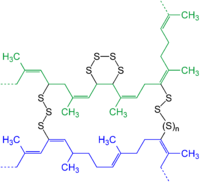
Photo from wikipedia
Abstract Conformance improvement by polymer gels continues to gain momentum in the field of water management in mature oilfields. A key component for a successful treatment is the identification of… Click to show full abstract
Abstract Conformance improvement by polymer gels continues to gain momentum in the field of water management in mature oilfields. A key component for a successful treatment is the identification of the most appropriate gel technology for a targeted reservoir. Advanced approaches provide efficient screening and ranking tools; however, to the best of our knowledge, no such approaches have been developed for polymer gels so far. In this study, we utilized a machine-learning technique to develop an advanced selection methodology for the application of polymer gels in injection wells. Historical data of four in-situ gel systems including bulk gels, high temperature bulk gels, colloidal dispersion gels, and weak gels were used to train logistic regression models. Data sets of 19 property or parameter were tested for potential outliers, missing values were imputed, and some variables were categorized in order to treat data gaps. To identify the most discriminating variables, the univariate entropy R 2 , stepwise regression, and area under ROC curve (AUC) heuristic technique were employed. The candidate variables were then modified according to some considerations like the match of univariate logistic probability to conformance engineering considerations. To consider the regional tendencies in application of polymer gels, we developed three probabilistic models that include different number of treating technologies. Furthermore, to meet the new developments in the application of some gel systems, we constructed a variant model without the treatment timing indicator (water cut) for each main logistic classifier. Results show that logistic classification models and their variants correctly predict the proper gel technology in more than 85% of projects in the training and validation samples with a minimum AUC of 0.9375. We also used a prediction profiler to visually monitor performances of the classifiers and certain tendencies were identified by the investigation of the mispredicted projects. The novelty of the new methodology is its capability to predict the most applicable gel technology for undiagnosed injection wells.
Journal Title: Journal of Petroleum Science and Engineering
Year Published: 2017
Link to full text (if available)
Share on Social Media: Sign Up to like & get
recommendations!